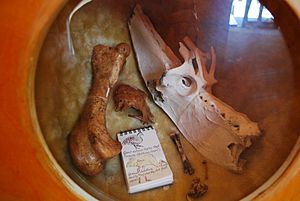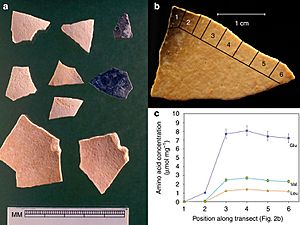Giant malleefowl facts for kids
Quick facts for kids Giant malleefowl |
|
|---|---|
 |
|
| Fossil remains from the Naracoote Caves | |
| Scientific classification |
|
| Kingdom: | Animalia |
| Phylum: | Chordata |
| Class: | Aves |
| Order: | Galliformes |
| Family: | Megapodidae |
| Genus: | Progura (De Vis, 1888) |
| Species | |
|
|
Progura was a type of giant bird that lived a long, long time ago in Australia. It is now extinct, meaning it doesn't exist anymore. This amazing bird belonged to a group called megapodes. Megapodes are known for building large nests on the ground, often using mounds of soil or plants. Scientists first found fossils of Progura in places like Darling Downs and Chinchilla in southeastern Queensland.
What Kind of Bird Was It?
Scientists have carefully studied the fossils of Progura. They found that Progura was closely related to a bird still alive today called the malleefowl (Leipoa ocellata). However, the fossil species L. gallinacea was much, much bigger than the modern malleefowl.
Another species, P. naracoortensis, was found in 1974 in the Naracoorte Caves National Park in South Australia. This species had slightly different sizes and leg shapes. For a while, scientists thought it might just be a different size of L. gallinacea, perhaps due to male and female differences. However, in 2017, scientists decided P. naracoortensis was actually a different type of giant bird. They moved it to a different group called Latagallina.
In that same 2017 study, a new second species of Progura was named: Progura campestris. Its fossils were found in the Nullarbor Plain.
How Big Was the Giant Malleefowl?
Scientists estimate that Progura weighed between 4 and 7 kilograms (about 8 to 15 pounds). This is quite heavy for a bird! Its leg bones were similar to those of the modern malleefowl, but much larger and stronger. It also had a wider beak, head, and body.
Even though it was very large, Progura likely could still fly. Scientists know this because its sternum (breastbone) had a deep keel. This keel is where strong flight muscles attach, showing that it was built for flying.
Giant Eggs of the Past
For a long time, some large fossil eggs were thought to belong to another giant Australian bird called Genyornis. However, scientists now believe these eggs actually belonged to the giant malleefowl, P. gallinacea.
It is thought that P. gallinacea buried its eggs in warm sand or soil to help them hatch. This is similar to how modern malleefowl build large mounds of sand and plants to incubate their eggs using natural heat.
Error: no page names specified (help). In Spanish: Talégalo leipoa gigante para niños
In Spanish: Talégalo leipoa gigante para niños


